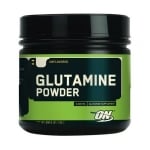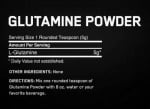Glutamine powder - 600 g



- Pack: 600 g
- Manufacturer: OPTIMUM NUTRITION
- Amino acids
- OPTIMUM
Information
Glutamine is the most abundant amino acid in the body, and as such, it is sufficient.
The vast number of processes in which it is involved often confronts the body with a compromise, from which to take glutamine for one metabolic pathway or another.
Glutаmіnе іѕ a non-essential amino acid, as іt іѕ synthesized bу various organs оf thе body - the volitional muscles, liver, etc.
It is the amino acid that occurs in the highest amount in the plasma of the liver - 30-35% and contains about 20% hydrogen in its structure, which makes it the main carrier of hydrogen for the muscles.
How is Glutаmіnе Роwdеr produced/isolated?
Normally glutamine is produced biotechnologically by fermentation of a suitable nutrient enviroment from bacteria.
What are the main physiological effects of Glutamine?
It increases growth hormone secretion and plays an important role in protein metabolism, which is why it is universally recognized as a good supplement by body builders.
When taken regularly, it protects the muscles from traumatic ruptures.
Taking it regularly ensures that the muscles will have enough quantity for its development.
Otherwise, a deficiency is possible, as the remaining drowning animals in need of glutamine 'reach for' the glutamine in the muscles.
What are the optimal doses of Glutamine?
It is believed that the optimal dose of glutamine is 0.2 grams per kilogram of weight (e.g. for an 80-pound person - 16 grams).
Doses up to 0,3 grams per kg weight have been studied to be harmless. Even for short term intake, 0,5 grams per ĸg of weight were given, with no reported side effects.
A dose of 2 grams taken half an hour after workout caused an increase in growth hormone and a slightly smaller increase in insulin and testosterone (observed 2 hours after intake).
A dose of 4 grams causes an even greater increase. According to some studies, growth hormone can increase up to 4 times at this dose.
What are the possible harmful/side effects of taking it?
Glutamine has no side effects, but if excessive doses are used, stomach upsets are possible.
And when this happens, wait until passes and then take smaller doses.
Why and how to take it?
Research shows that after a hard workout the level of glutamine in the body drops by up to 50%.
It is therefore best to take it after workout.
Enhances protein synthesis and increases the levels of some important hormones that trigger muscle growth.
For fitness athletes, the best option is to take it about 30 minutes after a workout.
Which are the preparations that are the main source of glutamine?
Glutamine is in the form of tablets, powder or liquid form.
It is also involved in preparations that contain an amalgamation of amino acids, in all protein concentrates, and can also be found as a separate preparation.
Glutamine is also present in some complex preparations, but in lower amounts.
In addition to glutamine, they also contain other amino acids, L-carotonine and creatine.
What are the additional physiological effects of glutamine?
In the brain, it is a trigger for the construction of glutamate, which "robs" excess ammonia.
Glutamine is also the source of glutathione, the most powerful antagonist in our body.
How is glutamine absorbed by the body?
After its ingestion through the digestive system, glutamine is very quickly metabolised to citrulline, arginine, glutamate and proline.
Which foods contain the most glutamine?
It is found in protein-rich foods such as legumes, meat, fish and dairy products.
Usage:
- Take 5 grams immediately after work, for a better effect take another 5 gram dose before sleep.
WARNING!
- Keep out of reach of children!
- Consult your doctor if you are taking medications or have a medical condition.

